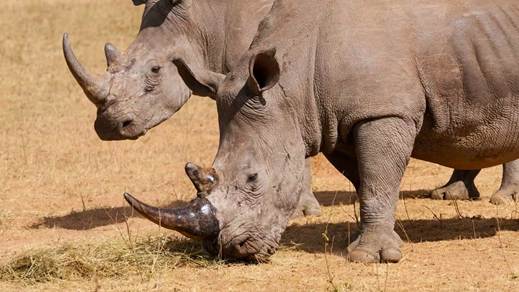Context: Rhisotope Project (South Africa)
- What? A novel anti-poaching initiative using radioactive isotopes injected into rhino horns.
- Where? Waterberg Biosphere Reserve, South Africa.
- Who? Led by the University of the Witwatersrand, supported by the IAEA (International Atomic Energy Agency).
Relevance: GS 3(Environment and Ecology)

Objective and Purpose
- Curb Illegal Wildlife Trade: By making horns detectable, useless for poachers, and dangerous for illicit trade.
- Avoid Animal Harm: Procedure aims to retain the horn (unlike dehorning) while not harming the rhino.
- Leverage Nuclear Security Tools: Uses existing Radiation Portal Monitors (RPMs) at borders, ports, and airports to detect the isotope-tagged horns.
How the Technology Works: Radioisotope Tagging
- Non-Invasive Technique: Low-dose radioactive isotopes are injected without surgery or structural changes.
- Mechanism:
- Isotopes emit low radiation, absorbed by keratin (horn material).
- This makes horns easily detectable using RPMs, even in containers.
- Mimics illegal nuclear material transport — already tracked globally.
- Safety Verified:
- Trials on 20 rhinos in June 2025.
- Cytological (cell-level) tests by Ghent University, Belgium.
- Compared 15 treated and 5 untreated rhinos — no biological damage found.
- Horn Becomes “Poisonous” to humans due to radioactive properties – deterrence through health risk.
Project Details
- Name: Rhisotope Project
- Cost: ~$290,000
- Timeframe: 6 years of development and testing
- International Collaboration: IAEA, Ghent University (Belgium), etc.
Significance for Global Conservation
- Poaching Crisis:
- 500,000 rhinos at start of 20th century → ~27,000 today.
- Poaching driven by demand for rhino horn (traditional medicine, status symbol).
- Current Strategy Limitations:
- Dehorning: Stressful and invasive.
- Militarized anti-poaching units: Expensive and confrontational.
- Demand-side regulation: Slow and ineffective in the short term.
- Radioisotope Approach:
- Non-lethal deterrence for humans.
- No harm to rhinos.
- Uses existing international security infrastructure (nuclear material tracking).
India-Specific Relevance & Ethical Dimensions
Conservation Lessons for India
- India faces similar threats (e.g., tigers, elephants, pangolins).
- Kaziranga and Manas National Parks have suffered rhino poaching.
- Rhisotope-like strategies could complement:
- Project Tiger / Project Elephant / Project Rhino
- CITES enforcement, NTCA monitoring systems
Ethical & Legal Considerations
- Is it ethical to use radioactive substances on animals?
- Supporters argue: If proven safe, it saves lives without harm.
- May require revision of domestic laws to allow such radioactive use on wildlife.
- Needs public acceptance, scientific transparency, and regulatory oversight.
International Cooperation & Technology Transfer
- Project shows successful model of science diplomacy in conservation.
- India could:
- Collaborate with South Africa for technical know-how.
- Propose similar tools for pangolin scale tracking (next big illegal wildlife trade).
- Seek IAEA, UNEP partnerships under South-South cooperation.
Critical Insights & Policy Implications
- Technological innovation is emerging as a critical conservation tool.
- Nuclear tech repurposed for peacetime wildlife protection – new frontier.
- Emphasizes deterrence through traceability, not just physical barriers.
- Demonstrates the importance of interdisciplinary solutions — blending wildlife science, nuclear physics, ethics, and law.
Conclusion
The Rhisotope Project represents a groundbreaking shift in anti-poaching strategies — one that is non-violent, tech-driven, and globally integrated. While not a silver bullet, its ability to act as a deterrent with minimal animal harm makes it a compelling model for India and other biodiversity-rich nations facing similar threats.



